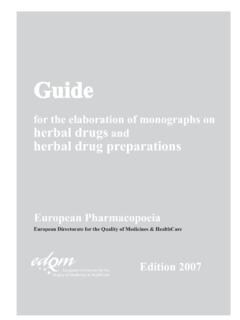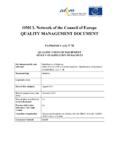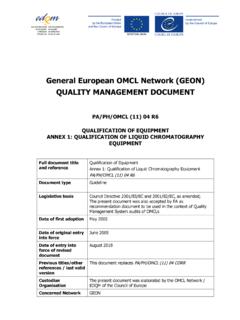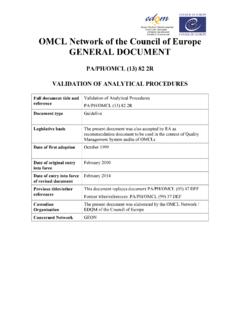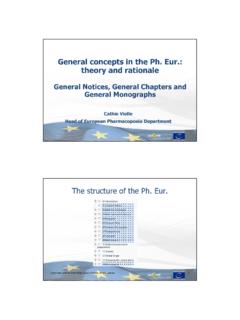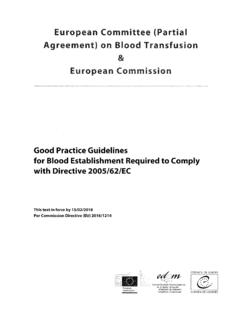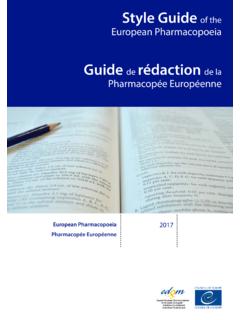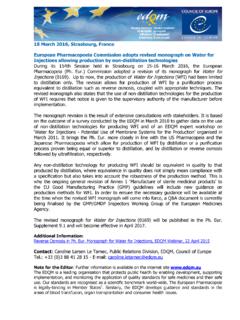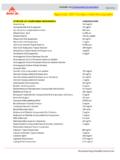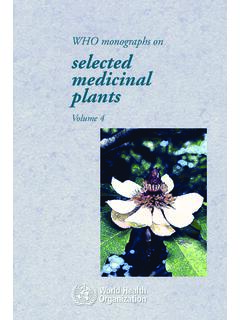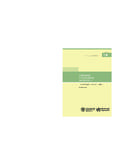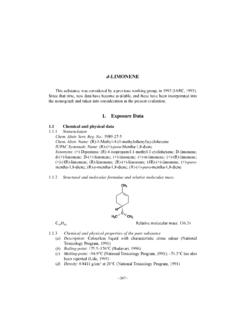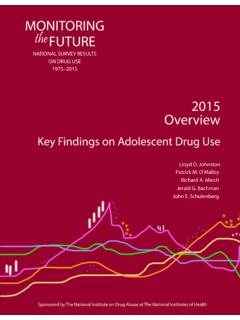Transcription of Technical guide for the elaboration of monographs - EDQM
1 EDQM7th Edition2015 The Council of Europe is the continent s leading human rights organisation. It comprises 47 member states, 28 of which are members of the European Union. The European Directorate for the Quality of Medicines & HealthCare (EDQM) is a directorate of the Council of Europe. Its mission is to contribute to the basic human right of access to good quality medicines and healthcare and to promote and protect public guide for the elaboration OF MONOGRAPHSE uropean PharmacopoeiaTechnical guide for the elaboration OF MONOGRAPHSE uropean Pharmacopoeia7th Edition2015 European Directorate for the Quality of Medicines & HealthCareEnglish version 2015 Making copies of this file for commercial purposes or posting it on a website for which access is charged is strictly prohibited. Re-use of the file, in whole or in part, requires that the source be clearly cited and the EDQM be Directorate for the Quality of Medicines & HealthCare (EDQM) Council of Europe 7, all e Kastner CS 30026 F-67081 STRASBOURG FRANCE Cover image: EDQM - Council of Europe Director of the Publication: Dr S.
2 KeitelPage layout: Council of Europe, 2015 Technical guide FOR THE ELABORATI ON OF monographs 7th Edition 2015 TABLE OF CONTENTS I. INTRODUCTION .. 1 PURPOSE OF THE guide .. 1 TEST PROCEDURES .. 1 EQUIPMENT .. 2 QUANTITIES .. 2 REAGENTS .. 4 COMMERCIAL NAMES .. 4 REFERENCE STANDARDS .. 4 II. MONOGRAPH ON A SUBSTANCE FOR PHARMACEUTICAL USE .. 5 TITLE .. 5 DEFINITION .. 6 Combinations .. 7 Content .. 7 CHARACTERS .. 8 Appearance .. 8 Taste .. 9 Odour .. 9 Solubility .. 9 Stability factors .. 10 Hygroscopicity .. 10 Solid-st ate properties .. 10 Other characteri stics .. 10 Behaviour in solution .. 11 IDENTIFICATION .. 11 General .. 11 Second Identification series .. 12 Infrared absorption spectrophotometry .. 13 Ultravio let and visible abs orption spectrophotometry .. 13 Melting point, freezi ng point and boiling point.
3 14 Specific optical rotation .. 15 Thin-layer chromatography .. 15 Gas chromatography and liquid chromatography .. 16 Chemical reactions .. 16 TESTS .. 16 General .. 16 Title of tests .. 17 Solution S .. 18 Appearance of solution .. 19 Clarity and degree of opalescence ( ) .. 19 Degree o f coloration ( ) .. 19 pH and Acidity or alkalinity .. 20 Optical rotation ( ) .. 21 Absorption spectrophotometry (ultr aviolet and vi sible) ( ) .. 22 Related substances .. 23 Thin-layer chromatography (TLC) ( ) .. 27 Liquid chromatography (LC) ( ) .. 28 Gas-liquid chromatography (GC) ( ) .. 33 Capillary electrophoresis (CE) ( ) .. 33 Readily carboni sabl e substances .. 34 Foreign anions and/ or cations .. 35 Heavy metals Elemental Impurities .. 35 Loss on drying ( ) .. 36 Thermogravimetry ( 4.) .. 36 Semi-micro determination of water ( ) (volumetric Karl Fi scher).
4 37 Micro determination of water (2. ) (coulometric Karl Fischer) .. 37 Gas chromatographic determination of water .. 37 Determination of water by disti llation ( ) .. 38 Sulfated ash ( 4.) .. 38 Residue on evaporation .. 38 Residual solvents ( ) .. 38 Bacterial endotoxins .. 38 ASSAY .. 39 Ultravio let and visible spectrophotometry ( ) .. 40 Direct measurement .. 40 Measurement after a colour reacti 40 Volumetric 40 Chromatography .. 41 Determination of nitrogen by sulfuric acid digestion ( ) .. 41 STORAGE .. 41 LABELLING .. 42 IMPURITIES .. 42 FUNCTIONALITY-RELATED CHARACTERISTICS .. 43 III. ANALYTICAL VALIDATION .. 44 DEFINITIONS AND TERMINOLOGY .. 44 Introducti on .. 44 Types of analytical procedures to be validated .. 44 Validati on characteristic s and requirements .. 45 Glossa ry .. 46 METHODOLOGY.
5 47 Introducti on .. 47 Specificity .. 48 Identification .. 48 Assays and impurity tests .. 49 Linearity .. 49 Range .. 50 Accuracy .. 51 Assay .. 51 Impurities (quantification) .. 51 Recommended data .. 51 Precisi on .. 51 Repeatabili ty .. 52 Intermediate precision .. 52 Reproduc ibili ty .. 52 Recommended data .. 52 Detection limit .. 52 Based on visual evaluation .. 52 Based on signal-to-noise ratio .. 52 Based on the standard d eviation of the response and the slope .. 53 Recommended data .. 53 Quantitation 53 Based on visual evaluation .. 53 Based on signal-to-noise ratio .. 53 Based on the standard d eviation of the response and the slope .. 54 Recommended data .. 54 Robustness .. 54 System suitability testi ng .. 55 SPECIF IC APPLICATION TO METHODS USED IN THE PH. EUR.. 55 Optical rotation ( ).
6 55 Introduction .. 55 Identification .. 55 Tests .. 55 Ultravio let spectrophotometry (2. ).. 56 Identification .. 56 Limit test .. 56 Assay .. 56 Non-instrumental limit tests .. 57 Appearance of solution ( and ) .. 57 Acidity or alkalinity .. 57 Limit tests for anions/cations ( ) .. 57 Atomic absorpti on spectrometry (2. ).. 58 Specificity .. 58 Calibration .. 58 Matrix ef fects .. 59 Detecti on and quantification limit (based on the standard deviation of the blank) .. 59 Separation techniques .. 59 Thin-layer chromatography ( ) .. 59 Liquid chromatography ( ).. 60 Gas chromatography ( ) .. 62 Semi-micro determination of water ( ) .. 63 Volumetric titrations (2. - - ) .. 64 Peptide identification by nuclear magnetic resonance spectrometry ( ) .. 66 1 I. INTRODUCTION PURPOSE OF THE guide This document is a guide for the authors of monographs and also a means of communicating the principles for the elaborati on of monographs to the users of the European Pharmacopoeia (Ph.)
7 Eur.), espec ial ly industry, licensing authorities and official medicines control laboratories. Since the principles applied and guidance given for the elaboration of monographs should be the sa me as those applied by licensing authorities, the Technical guide may also serve as a guideline in the elaboration of specifications intended for inclusion in licensing applications. It is necessary to bear in mind that a monograph will be a mandatory standard and must be applicable in li censing procedures in a ll Member Stat es of the Convention on the elaboration of a European Pharmacopoeia. TEST PROCEDURES The methods chosen for the identification tests, purity tests and assay(s) constituting the bulk of a pharmacopoeial monograph are preferably those already described and utilised in the Ph. In this context, the author of a monograph is referred not only to the General Methods of the Ph.
8 But also to published monographs on similar materials. The above considerations aim at ensuring a reasonable degree of harmonisation within the Ph. Eur. and they only apply in cases where the methods are found to be adequate for the specific purposes. However, due attention is also to be paid to the development of new methods that offer significant improvements in terms of sensitivity, precision, accuracy or discriminating power (selectivity). Methods included in monographs must be validated as described in the chapter on analytical validation and other relevant specific chapters of this guide . Validation reports are provided to the EDQM but are not published or otherwise provided to users. The test procedures included in a monograph should be verified in 2 or more laboratories and the laboratory reports on this verification should be provided to the EDQM to ensure future traceability.
9 The instructions describing any method of analysis cover all factors that can influence the results and that are deemed essential to enable an experienced analyst working according to acknowledged laboratory practices, yet without necessaril y having an y prior knowledge of the investigation in question, to perform the analysis. Variations in the description of similar methods are to be avoided. If an analytical procedure is expected to be used generally or if it requires a lengthy description and is used more than once, it may be proposed for inclusion in the general chapters of the Ph. Eur., to be referred to in the individual monographs . The methods are presc ribed on the scale conventionally applied in the Ph. Eur. except in cases where for r easons of availability of the mate rial to be analysed, or because of its toxici ty or it s cost, work on a small scale would be advantageous.
10 2 EQUIPMENT If the equipment utilised for a method of analysis is not generally available in the Stat es party to the European Pharmacopoeia Convention, it must be possible to have it constructed according to its description in the Ph. Eur. QUANTITIES In prescribing the quantities, masses and volumes, of substances, reagents, and solvents to be taken for identifications, tests and assays, it is the practice of the Ph. Eur. to indicate the accuracy with which they are to be measured (see General Notices). It is therefore necessary to take this aspect into consideration when drafting pharmacopoeial texts. As guidance to minimise errors in the preparation of analytical solutions, Table 1, giving estimations of the relative uncertainty, is to be consulted. In order to avoid either the use of extremely low amounts or an unnecessarily large expenditure of solvents, a dilution series will often have to be presc ribed for the preparation of dilute solutions used particularly for spectrophotometric measure ment.
